Plein Air at the Fair

 Three years ago, the Wisconsin State Fair began inviting artists to paint during the fair. The first year, it was raining hard when I got there and I set up inside a dairy barn. Two dairy breed steers were tied right beside the door and I painted them. I received "Best Dairy Animal" for this painting though they were obviously not cows. The next year, it was again raining; I did paint cows and received "Grand Champion." This year, the weather was dry, but still I returned to the barn and painted the dairy cows. This one also won. I have really enjoyed doing the cows, they move, constantly standing up and laying down; I just wait for them to do again what I want to get. I make a big space to house them and then watch them carefully as they move in that space..
Three years ago, the Wisconsin State Fair began inviting artists to paint during the fair. The first year, it was raining hard when I got there and I set up inside a dairy barn. Two dairy breed steers were tied right beside the door and I painted them. I received "Best Dairy Animal" for this painting though they were obviously not cows. The next year, it was again raining; I did paint cows and received "Grand Champion." This year, the weather was dry, but still I returned to the barn and painted the dairy cows. This one also won. I have really enjoyed doing the cows, they move, constantly standing up and laying down; I just wait for them to do again what I want to get. I make a big space to house them and then watch them carefully as they move in that space..
Liking this subject, I also painted them at the Walworth County Fair and Jefferson County Fair. Holsteins are hard to paint because their markings distract from their form. The balance has to be just right. The junior exhibitors take wonderful care of their animals and they are very nice about letting me paint them.

 Three years ago, the Wisconsin State Fair began inviting artists to paint during the fair. The first year, it was raining hard when I got there and I set up inside a dairy barn. Two dairy breed steers were tied right beside the door and I painted them. I received "Best Dairy Animal" for this painting though they were obviously not cows. The next year, it was again raining; I did paint cows and received "Grand Champion." This year, the weather was dry, but still I returned to the barn and painted the dairy cows. This one also won. I have really enjoyed doing the cows, they move, constantly standing up and laying down; I just wait for them to do again what I want to get. I make a big space to house them and then watch them carefully as they move in that space..
Three years ago, the Wisconsin State Fair began inviting artists to paint during the fair. The first year, it was raining hard when I got there and I set up inside a dairy barn. Two dairy breed steers were tied right beside the door and I painted them. I received "Best Dairy Animal" for this painting though they were obviously not cows. The next year, it was again raining; I did paint cows and received "Grand Champion." This year, the weather was dry, but still I returned to the barn and painted the dairy cows. This one also won. I have really enjoyed doing the cows, they move, constantly standing up and laying down; I just wait for them to do again what I want to get. I make a big space to house them and then watch them carefully as they move in that space..Liking this subject, I also painted them at the Walworth County Fair and Jefferson County Fair. Holsteins are hard to paint because their markings distract from their form. The balance has to be just right. The junior exhibitors take wonderful care of their animals and they are very nice about letting me paint them.
Summer! It's Plein Air Time
Summer, Its Plein Air Time!

This is a pedestrian bridge over the Rock River. Its very small, 8 x 10
My daughter, Mary Kathleen Lynch came out to join me for some Plein Air events in Wisconsin this summer. Its nice to have company, and she’s a great help with all the slepping. The "paint out" we did was in Jefferson. Here she is painting the dam.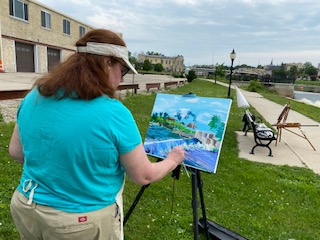
Here I am, painting “Goat Island,” an island in the middle of the River where goats live all summer.
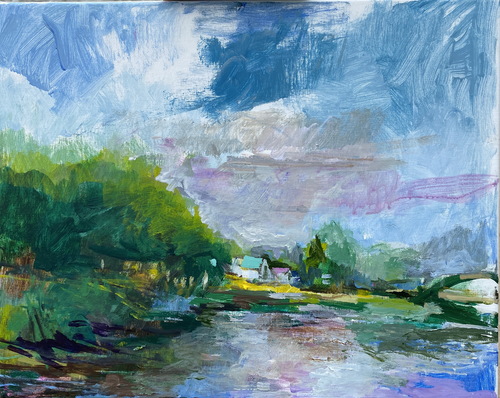
This is "Goat Island," acrylic, 16 x 20.
I like the big open space here, the tumultous sky which covers all, the simplification of the greens, the lightness of touch, and the delicate balance of warm and cool.
Summer, Its Plein Air Time!

This is a pedestrian bridge over the Rock River. Its very small, 8 x 10
My daughter, Mary Kathleen Lynch came out to join me for some Plein Air events in Wisconsin this summer. Its nice to have company, and she’s a great help with all the slepping. The "paint out" we did was in Jefferson. Here she is painting the dam.

Here I am, painting “Goat Island,” an island in the middle of the River where goats live all summer.


This is "Goat Island," acrylic, 16 x 20.
I like the big open space here, the tumultous sky which covers all, the simplification of the greens, the lightness of touch, and the delicate balance of warm and cool.
Summer Painting, 2022
The Pandemic Christmas

It takes me about a year to decide whether a painting is finished, and to determine if it is something I want to exhibit. Now I am looking critically at my Christmas Pandemic Paintings from last year.
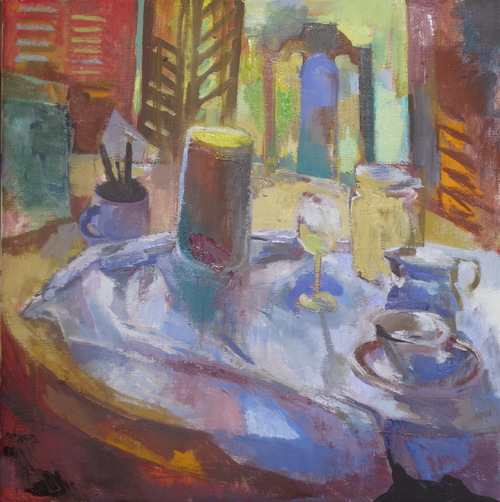
Last winter, a little before Christmas, with lockdown in full force, I decided to move my studio downstairs. I was having difficulty with the stairs and downstairs is warmer. Shutting off upstairs would save heat. My family helped roll up the rugs, move painting tables and easels, and we set up the studio in the kitchen and dining room. The Pandemic meant no visitors would come. I could let the house and studio turn into as big a mess as I wanted.
I tend to like accidental still lives, and one was already “setup” on the dining room table.
Eager to get to work, I stretched a group of large canvases.
I used the dining room table for a setup. I did not think about the chairs. At first, I just shoved them out of the way. My oldest son was leaving groceries on the porch. It was lonely, but I was getting a lot done.
I realized after working awhile, that all the chairs were empty, and I felt lonely because in a normal Holiday season, they would be full. I felt sad and I realized I was making a “pandemic” painting.
Later my son noticing the Clorox wipes in the painting, said, “we’ll always know when this was made.”


After he began to work from home, he thought it safe to come inside. One day he brought two pineapples. Another day, a poinsettia. Christmas music was playing. He looked at the largest painting and said, this is a pandemic painting, all the chairs are empty. "Yes," I said, "all the chairs are empty, and that will be our Christmas this year."
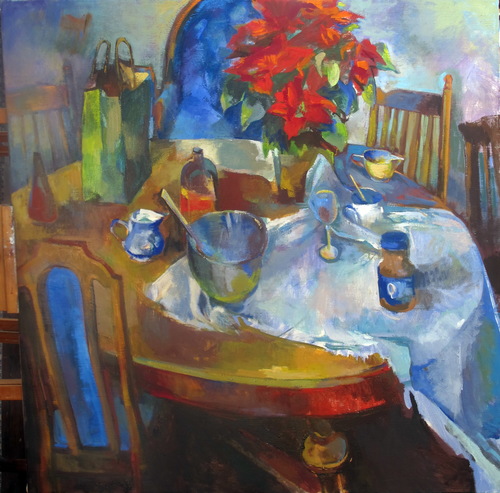
I added some of the utensils for making Christmas Cookies to the table. My children's favorite Christmas cookies are Pineapple Diamonds.
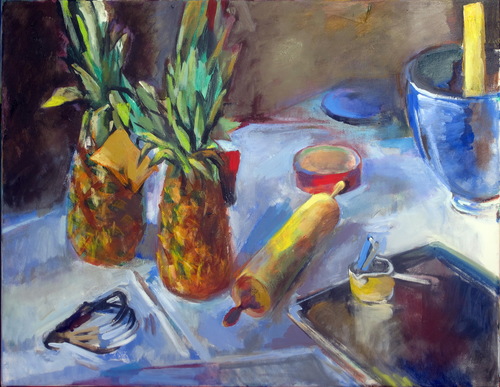
Next came the pastry blender and the rolling pin. A rolling pin is taperred at the ends and devilish to foreshorten, but it, along with the pan and the tablecloth establish the ground plane.
Would you like to have a Christmas card with an image and the recipe? Use contact to message me, please..

It takes me about a year to decide whether a painting is finished, and to determine if it is something I want to exhibit. Now I am looking critically at my Christmas Pandemic Paintings from last year.

Last winter, a little before Christmas, with lockdown in full force, I decided to move my studio downstairs. I was having difficulty with the stairs and downstairs is warmer. Shutting off upstairs would save heat. My family helped roll up the rugs, move painting tables and easels, and we set up the studio in the kitchen and dining room. The Pandemic meant no visitors would come. I could let the house and studio turn into as big a mess as I wanted.
I tend to like accidental still lives, and one was already “setup” on the dining room table.

Eager to get to work, I stretched a group of large canvases.
I used the dining room table for a setup. I did not think about the chairs. At first, I just shoved them out of the way. My oldest son was leaving groceries on the porch. It was lonely, but I was getting a lot done.
I realized after working awhile, that all the chairs were empty, and I felt lonely because in a normal Holiday season, they would be full. I felt sad and I realized I was making a “pandemic” painting.
Later my son noticing the Clorox wipes in the painting, said, “we’ll always know when this was made.”


After he began to work from home, he thought it safe to come inside. One day he brought two pineapples. Another day, a poinsettia. Christmas music was playing. He looked at the largest painting and said, this is a pandemic painting, all the chairs are empty. "Yes," I said, "all the chairs are empty, and that will be our Christmas this year."

I added some of the utensils for making Christmas Cookies to the table. My children's favorite Christmas cookies are Pineapple Diamonds.

Next came the pastry blender and the rolling pin. A rolling pin is taperred at the ends and devilish to foreshorten, but it, along with the pan and the tablecloth establish the ground plane.
Would you like to have a Christmas card with an image and the recipe? Use contact to message me, please..
North to Alaska

Taking a cruise
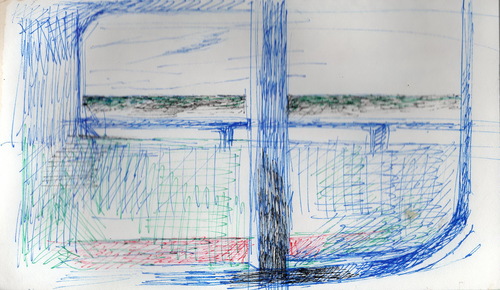
This is a form of travel which I once disparaged. I was willing to go anywhere and try everything, walking, hauling, hanging onto children, going a long way out of the way to save a little. Those days are gone. Now that I can’t walk so well, there are ways to make it easier. I can ask for a wheelchair in an airport, I can do much more preplanning, and I can take a cruise. Cruises get me to interesting places, give me a place to stay or rest, and don’t require handling luggage. If you shop a bit, you can find offers that even make this affordable, and a bit of luxury is nice.
This amazing year, I have been to both the Artic and the Antartic! My daughter Bridget and my sons Edward and John accompaned me a trip to Alaska this August.

Ketchikan, watercolor and charcoal
Bridget and Edward are Anthropologists, and we spent time looking at work by the original inhabitants of Alaska. Very amazing are the Tlingits, a seafaring people, skilled fishers, traders and hunters-gatherers, who are located in southern Alaska, in the temperate rainforest between the Pacific ocean and Canadian mountains. Unlike tribes farther north, the Tlingats had abundant fish, hunting and gathering and didn’t need a word for starvation. They were able to develop wonderful weavings and carvings, used in ritual dances which depicted tales like their origination story; Raven stealing the sun from a wealthy man who kept it hiden, and bringing it to the people. These dances, which were done in clan houses, painted on the outside, and lit by a central fire inside, must have been very magical.
The Tlingit, along with other costal tribes erected totem poles to commemorate births, deaths and other important events. Originally carved with stone tools until the arrival of Europeans who brought metal tools, the poles were left until they fell.

Historical Villages with Poles

Elaborate poles were (and still are) carved to commenorate special ocassions
Formline Design
The patterns chosen for weavings and carvings are very purposeful, depicting highly stylized and geometric patterns of native animals. The central designs of Tlingit blankets are created from formlines, a rigid framework of designs with a longstanding legacy of usage by Northwest Coast groups. Specific blankets also tend to draw upon designs related to family histories. This design is perhaps the most common Tlingit blanket design: the diving whale.
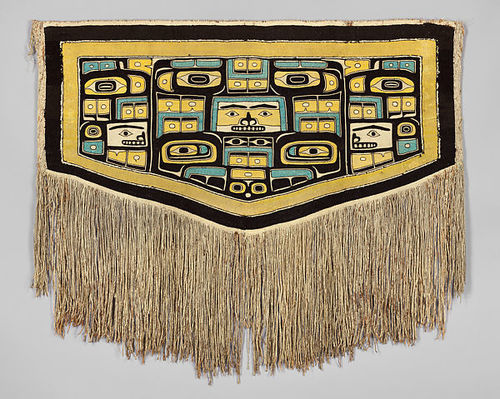
Juneau, Alaska's capitol, allows trips to glaciers, and a ride on the Mt. Roberts Tramway.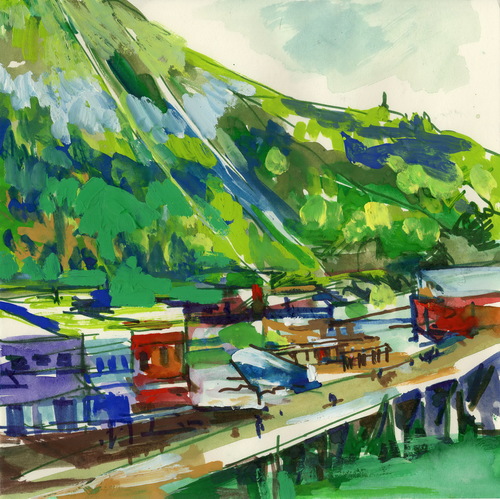
Icy Point Straight has a Cannery Museum.
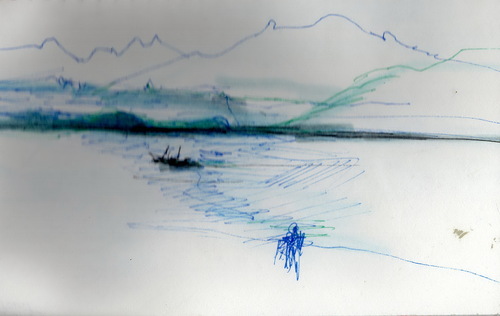

Sitka, pastel
I drew Fjords, Straights and Glaciers from the deck of the ship.
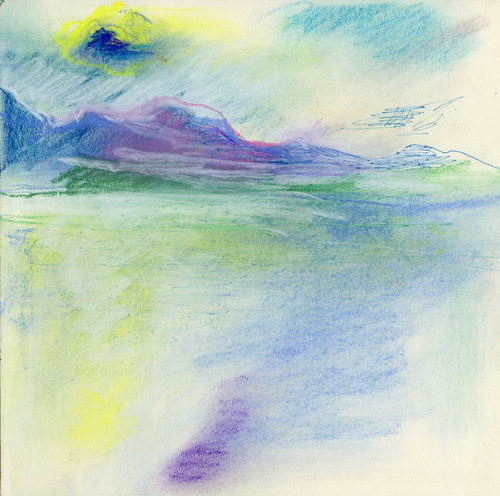
Gulf of Alaska, watercolor and pastel
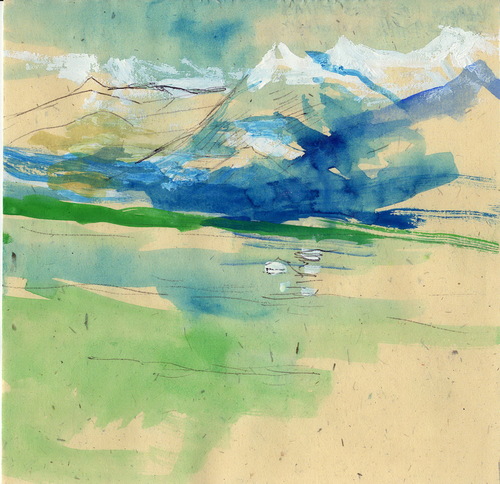
St. Elias Mountain, watercolor, charcoal
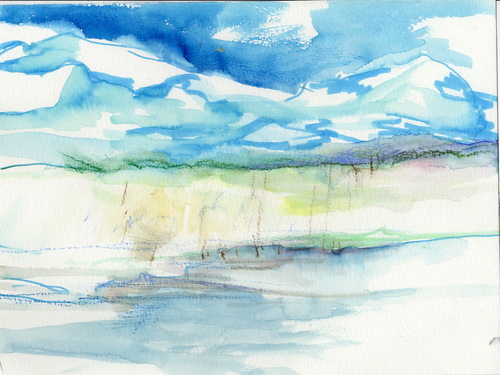
Wrangell St. Elias National park is our largest National Park, It is accessible only by water. This is a view of Hubbard Glacier.

Tracy Arm

Homer Spit, gouache
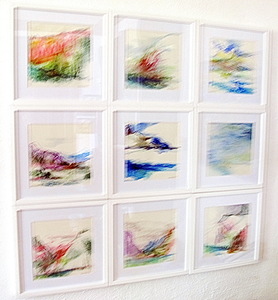
This wall of Alaska Sketches are hung "quilt" style. These quick sketches of Tracy Arm and Wrangle St. Elias capture light, scale and a sense of place. They can be hung singly or in any combination. $160 each framed 14 x 14. Shipping is included.

Taking a cruise

This is a form of travel which I once disparaged. I was willing to go anywhere and try everything, walking, hauling, hanging onto children, going a long way out of the way to save a little. Those days are gone. Now that I can’t walk so well, there are ways to make it easier. I can ask for a wheelchair in an airport, I can do much more preplanning, and I can take a cruise. Cruises get me to interesting places, give me a place to stay or rest, and don’t require handling luggage. If you shop a bit, you can find offers that even make this affordable, and a bit of luxury is nice.
This amazing year, I have been to both the Artic and the Antartic! My daughter Bridget and my sons Edward and John accompaned me a trip to Alaska this August.

Ketchikan, watercolor and charcoal
Bridget and Edward are Anthropologists, and we spent time looking at work by the original inhabitants of Alaska. Very amazing are the Tlingits, a seafaring people, skilled fishers, traders and hunters-gatherers, who are located in southern Alaska, in the temperate rainforest between the Pacific ocean and Canadian mountains. Unlike tribes farther north, the Tlingats had abundant fish, hunting and gathering and didn’t need a word for starvation. They were able to develop wonderful weavings and carvings, used in ritual dances which depicted tales like their origination story; Raven stealing the sun from a wealthy man who kept it hiden, and bringing it to the people. These dances, which were done in clan houses, painted on the outside, and lit by a central fire inside, must have been very magical.
The Tlingit, along with other costal tribes erected totem poles to commemorate births, deaths and other important events. Originally carved with stone tools until the arrival of Europeans who brought metal tools, the poles were left until they fell.

Historical Villages with Poles

Elaborate poles were (and still are) carved to commenorate special ocassions
Formline Design
The patterns chosen for weavings and carvings are very purposeful, depicting highly stylized and geometric patterns of native animals. The central designs of Tlingit blankets are created from formlines, a rigid framework of designs with a longstanding legacy of usage by Northwest Coast groups. Specific blankets also tend to draw upon designs related to family histories. This design is perhaps the most common Tlingit blanket design: the diving whale.

Juneau, Alaska's capitol, allows trips to glaciers, and a ride on the Mt. Roberts Tramway.

Icy Point Straight has a Cannery Museum.


Sitka, pastel
I drew Fjords, Straights and Glaciers from the deck of the ship.

Gulf of Alaska, watercolor and pastel

St. Elias Mountain, watercolor, charcoal

Wrangell St. Elias National park is our largest National Park, It is accessible only by water. This is a view of Hubbard Glacier.

Tracy Arm

Homer Spit, gouache

This wall of Alaska Sketches are hung "quilt" style. These quick sketches of Tracy Arm and Wrangle St. Elias capture light, scale and a sense of place. They can be hung singly or in any combination. $160 each framed 14 x 14. Shipping is included.



